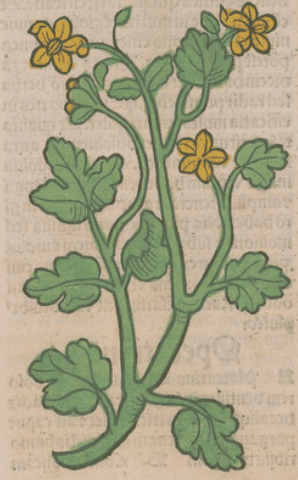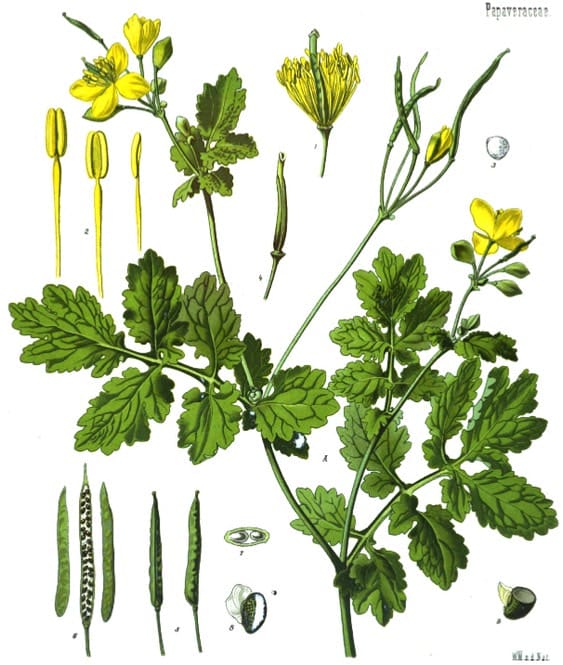Chelidonium majus, CelandineAlso called Hirundinaria or Swallow-wortBai Qu Hai (TCM) Stong ri zil pa སྟོང་རི་ཟིལ་པ་ (Tibetan) |

|
 Ortus Sanitatis, Meydenbach, 1491
Ortus Sanitatis, Meydenbach, 1491 Kohler’s Medizinal Pflanzen, 1887
Kohler’s Medizinal Pflanzen, 1887Botanical name:
Chelidonium majus
Parts used:
Whole plant in flower; Root
Temperature & Taste:
Cold (classed as Warm), dry. Bitter, pungent
Classifications:
2F. PURIFYING. 2G. CLEANSING. 2K. RESOLVENT
4b. OPTHALMIC
Uses:
1. Clears Liver Heat, Clears Damp-Heat, Opens Obstructions:
-’purges Choler (Bile) by stool and urine’ (Schroder);
-obstruction of the Liver and Spleen: used for Jaundice, Cholecystitis, Gall Stones
-Hepatitis, Liver Swelling
-root is especially commended for Jaundice (Unani)
-promotes Urine; used for obstruction of the urine
-Headache, Migraine, Hypertension
2. Promotes Sweat, Resists Poison:
-Cold, Flu, Infectious diseases (both to prevent and cure)
-often used in Antidotes and Preservatives
-used for Poisons
3. Clears Heat, Stops Cough:
-heat-type Cough, chronic Bronchitis, Asthma, Whooping Cough
4. Moves the Blood, Clears Stasis:
-promotes Menstruation (the salts of the Roots of Celandine were also used).
-Palpitations, Angina and stabbing Chest Pain.
-Tumors, Cancers (Breast, Bowel, Kidney, Liver, Spleen, Stomach, Uterus, Mouth, Jaw and Testicles)
-Bruising, congealed Blood
5. Clears the Sight:
-internally and topically to clear Heat from the Eyes, improve Eyesight and remove visual obstructions
-clears the Eyes, quickens the Sight (juice boiled with Honey and applied: Dioscorides)
-sore, red eyes, Conjunctivitis; Films and Cloudiness of the Eyes (juice applied with milk or the ointment applied to the eyelids)
-it has been used for Blindness
-Cataracts; the fresh juice, preserved with Olive oil is applied to advanced cases of Cataract daily for up to 4 months to cure (Meyer)
-in eye salves for Dim-sightedness since ancient Greece.
-often regarded as superior to Eyebright for the Eyes.
6. Preserves Health:
-‘The Essence hereof preserves from old age, or makes age look youthful’ (Salmon)
-often credited with preserving youth.
7. Externally:
-externally for the eyes, for styes, sores and ulcers of them (diluted juice, infusion, or juice mixed with the distilled water, or the thickened juice which is best)
-Toothache (fresh herb chewed, root powder applied, or the herb boiled in wine used as a mouthwash)
-juice is applied to Warts and Corns, Ringworm, Itchy Skin, Tinea, Eczema, Herpes, as well as Tumors and Cancers
-internally and externally for chronic and filthy sores and ulcers, especially of the legs (Juice applied)
-decoction is gargled for Toothache; or the root can be chewed.
-‘Some … writers believe that this agent is superior to Arnica or Hamamelis, as an external application to bruises and sprains’ (Ellingwood)
–Salmon said applied as a Cataplasm to the Breast hinders excessive menstruation
-Breast Cancer, applied topically
Comment:
Research has shown that only Celandine herb that is dried in a temperature of 80º C maintains alkaloid contents as that of the fresh herb; when it is dried between 20-50º C, up to half or more of the alkaloid content is lost. Further, there is a great loss of effect after about 6 months of storage of either the herb, or of preparations of it, meaning that this is an herb that should be grown by herbalists who wish to use it.
Dose:
Herb or Root in Decoction (or infusion): 2–6 grams (up to 10 or 15 grams), or 5–20 grams fresh
Tincture (1:10 in 45% alcohol): 2–4 or 5 mls. (up to 3 drams were traditionally given)
Fluid Extract (1:1 in 25% alcohol): 1–3, or 4 mls.
Fresh Juice: 10–20 drops
Dehydrated Juice: 200–500mg (up to 1 gram)
Used externally in washes, poultices, compresses, ointments, eye baths, gargles etc.
Correctives:
1. Honey
2. Tragacanth
3. Dodder
4. Aniseed
Main Combinations:
1. Infection of Epidemic diseases (including Plague) Celandine with Rue, Blessed Thistle, Lemon peel, Zedoary, Angelica, Cinnamon (as in Bezoar Water)
2. To prevent and treat Epidemic diseases:
i. Celandine juice with 1 dram of Mithridate
ii. Celandine with Scorzonera, Dittany, Zedoary, Angelica, Gentian, Tormentil, Elecampane (as in Bezoardic Vinegar of Frankfurt)
iii. Celandine with Walnut, Juniper berry, Citron peel, Angelica, Gentian, Elecampane, Blessed Thistle, Saffron (as in Treacle Vinegar)
iv. Celandine with Rosemary, Rue, Sage, Mugwort, Wormwood, Balm, Blessed Thistle, Angelica, Tormentil, Gentian, Zedoary, Licorice (as in Plague Water)
3. Jaundice:
i. Celandine with St. Johns wort and Saffron
ii. Celandine with Madder and Turmeric
iii. Celandine root (2 handfuls), Juniper berry (1 handful) (Gazophylacium Medico-Physicum, Woyts, 1746)
iv. Celandine with Madder, Wormwood, Centaury, Cinnamon, Saffron
4. Jaundice and Liver obstruction, Celandine with Aniseed, decocted in wine (Gerard)
5. Gall Stones, Cholecystitis:
i. Celandine with Barberry and Dandelion (BHP)
ii. Celandine with Wormwood, Hyssop, Horehound (as in Decoction for the Gall Bladder)
6. Paralysis; Salmon said the constant use of the Tincture (for 6 months) cured one of Paralysis
7. For the eyes, combine Celandine with Eyebright and Fennel seed
8. Fractures, decoct Celandine in wine with Pepper, add Honey, and drink for 9 days. (Physicians of Myddvai)
9. As a bath for Eczema, Celandine with Elecampane, Artichoke leaf, Chicory, Broom flowers, Lavender and Nettle
10. Itch, Dandruff, Eczema, apply the juice Celandine (4 oz.), Olive oil 1 oz.) with Sulphur (1 ½ oz.)
11. Distilled water to apply to the Eyes: Celandine with Fennel seed, Rue, Eyebright, Clove, Camphor and Aloes; steeped in Wine and Rose water and distilled. For Heat, Pain, Redness, Inflammations, Cloudiness of the Eyes; also Fistulas, Cataracts etc.
12. Stye, Celandine juice mixed with honey and breast milk. (Natura exenterata, Philiatros, 1655)
13. Old and putrified Wounds, beat Celandine and apply with old Suet (The Secrets of Alexis, 1615)
14. Breast Cancer, apply the juice with an equal amount of Goose dung
‘DEFENDER FROM DEATH‘
Clove, Nutmeg, Cardamon, Cubeb, Mastic,
Ginger, Rosemary, Rue, Scabious 2 oz. each
Powder, and mix with equal parts Celandine juice and Brandy, enough to cover by 2 finger-widths, for 24 hours. Distil in a water bath with a gentle heat, and keep for use. (The Practise of the New and Old Phisicke, Gesner, 1599)
WATER OF YOUTH
Aloeswood, Clove, Ginger, Galangal,
Cardamon, Cubeb, Grains of Paradise,
Rhubarb, Cinnamon, Nutmegs, Aloe,
Calamus, Mace 2 drams each
Powder and seive, then add them to:
Celandine juice 2 pints
Juice of Sage, Bryony, Bugloss, Fumitory,
Rue, Betony, Mint, Borage, Fennel ½ pound each
Mix, add white wine, then distil. Dose: 1 spoonful in the summer, 2 spoonfuls in the winter. (The Practise of the New and Old Phisicke, Gesner, 1599)
Major Formulas:
Tincture of Celandine
Infusion for Jaundice (Riverius)
Decoction for Jaundice
Decoction for the Gall Bladder (2)
Decoction to Cleanse the Sight (Riverius)
Syrup of Betony (Bononiense)
Electuary for the Eyes (Grulingus)
Confection of Eyebright (Confectio Humain) (Mesue)
Cautions:
1. Avoid during pregnancy
2. Toxic in overdose
Toxicity
–Hepatotoxicity induced by greater celandine (Chelidonium majus L.): a review of the literature.
–Greater Celandine hepatotoxicity: a clinical review.
–Suspected Greater Celandine hepatotoxicity: liver-specific causality evaluation of published case reports from Europe.
Main Preparations used:
Extract/Dehydrated Juice, Distilled Water of the herb, Salt of the Ashes
1. Extract of Celandine:
i. Bruise a sufficient quantity of fresh Celandine with a little water; express the juice and immediately evaporate in a water-bath, stirring constantly. (Pharmacopoeia Wirtembergica, 1798)
ii. Bruise a sufficient quantity of fresh Celandine with a little water; express the juice and immediately evaporate in a water-bath until thick enough that a fourth part of powdered Celandine is required to make an extract.
iii. Celandine (1 lb.), Boiling Water (10 lbs.). Digest 24 hours, then boil for 2 hours, then strain; boil the residue again with Water (8 lbs.), and strain and press. Mix the 2 liquors and evaporate to the consistency of an extract. (Belgium Pharmacopoeia)
2. Distilled Water of Celandine:
i. Celandine (1 part), Water (2 parts). Distil two-thirds. (Pharmacopoeia Sardoa, 1773)
3. Honey of Celandine:
i. Honey (3 lbs.), Celandine Juice (2 lbs.). Boil together until no more scum is formed, then strain through flannel and evaporate to the consistency of Honey. Mostly used externally as a detergent. (Dispensatorium Fuldense, 1791)
Last Updated 02/24
